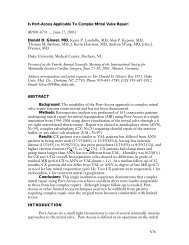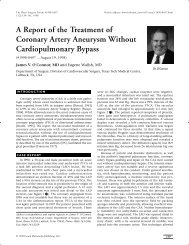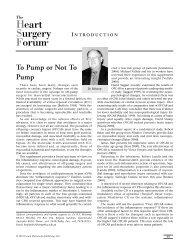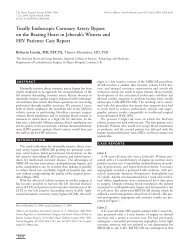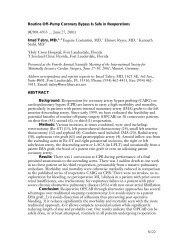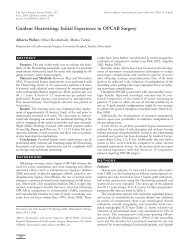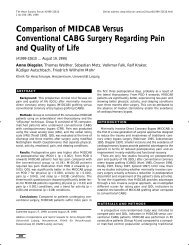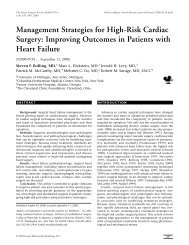Atraumatic Coronary Artery Bypass (ACAB): Techniques and Outcome
Atraumatic Coronary Artery Bypass (ACAB): Techniques and Outcome
Atraumatic Coronary Artery Bypass (ACAB): Techniques and Outcome
You also want an ePaper? Increase the reach of your titles
YUMPU automatically turns print PDFs into web optimized ePapers that Google loves.
The Heart Surgery Forum #2001-6108<br />
4 (4):331–334, 2001<br />
Online address: www.hsforum.com/vol4/issue4/2001-6108.html<br />
<strong>Atraumatic</strong> <strong>Coronary</strong> <strong>Artery</strong> <strong>Bypass</strong> (<strong>ACAB</strong>): <strong>Techniques</strong> <strong>and</strong><br />
<strong>Outcome</strong><br />
(#2001-6108)<br />
Thomas A. Vassiliades, Jr., MD<br />
Pensacola Heart Institute, Pensacola, FL<br />
Dr. Vassiliades<br />
INTRODUCTION<br />
Minimally invasive coronary artery bypass grafting continues<br />
to progress through multiple levels of development. We<br />
propose several modifications to single-vessel coronary artery<br />
bypass grafting (CABG) that we believe significantly decrease<br />
the physical trauma to the patient without appreciably<br />
increasing the technical difficulty of the operation.<br />
PATIENTS AND METHODS<br />
Patients<br />
Between November 1996 <strong>and</strong> May 2001, we performed<br />
300 minimally invasive coronary artery bypass (MICAB) procedures<br />
using endoscopic internal mammary artery harvesting.<br />
The 300 patients (191 male/109 female) ranged in age<br />
from 28 to 85 years, with a mean age of 69.8. Clinical presentation<br />
of New York Heart Association (NYHA) classification<br />
consisted of class I (47.3%), class II (40.8%), class III (7.4%),<br />
<strong>and</strong> class IV (4.5%). All patients presented for operation in<br />
one of five categories as outlined in Table 1 ( ). Of all<br />
patients, 74 (24.6%) had experienced a documented myocardial<br />
infarction within one week of surgery <strong>and</strong> 122 (40.7%)<br />
had a previous catheter-based intervention to the left anterior<br />
descending artery (LAD). Eleven patients (3.67%) had previously<br />
undergone CABG with all vein grafts.<br />
Presented at the Minimally Invasive Cardiac Surgery (MICS) Symposium,<br />
Key West, Florida, May 27, 2001.<br />
Address correspondence <strong>and</strong> reprint requests to: Thomas A. Vassiliades, MD,<br />
Cardiothoracic Surgical Associates of Northwest Florida, 5151 North Ninth<br />
Avenue, Suite 200, Pensacola, FL 32504, Phone: (850) 857-1734, Fax: (850)<br />
857-1747, Email: vassiliades@pol.net<br />
Methods<br />
The atraumatic coronary artery bypass (<strong>ACAB</strong>) technique<br />
consists of endoscopic internal mammary harvesting followed<br />
by an atraumatic chest incision through which a direct-vision<br />
anastomosis is performed using conventional instruments.<br />
For left internal mammary artery (LIMA) harvesting, the<br />
patient’s left side is rotated about 20 degrees off the table.<br />
Ports for the endoscope are usually placed at the fifth intercostal<br />
space in the anterior axillary line (5 mm scope), at the<br />
seventh intercostal space slightly more anterior for a grasper,<br />
<strong>and</strong> in the anterior axillary line that utilizes the third <strong>and</strong><br />
fourth intercostal spaces for cautery <strong>and</strong> smoke evacuator. Single-lung<br />
ventilation <strong>and</strong> carbon dioxide insufflation is safe <strong>and</strong><br />
absolutely necessary in providing the space needed to harvest<br />
the entire length of the LIMA. Carbon dioxide at levels of 8<br />
to 10 mmHg, when introduced gradually, pushes the heart<br />
<strong>and</strong> mediastinal fat pad away from the chest wall, greatly facilitating<br />
dissection. The LIMA is then harvested from its subclavian<br />
artery origin to the sixth rib as a pedicled graft using<br />
the electrocautery device on a low setting. Details of the technique<br />
of endoscopic dissection have been provided previously<br />
[Vassiliades 2000]. Control of the thoracoscope is best accomplished<br />
using a voice-activated robotic arm (AESOP, Computer<br />
Motion, Inc., Goleta, CA). A human assistant cannot hold<br />
<strong>and</strong> maneuver the scope with the precision that is necessary to<br />
perform a time-efficient harvest. Additionally, the ability to<br />
save positions in three-dimensional space allows rapid movement<br />
up <strong>and</strong> down the length of the LIMA. The lateral endoscopic<br />
view allows a harvest that is more accurate <strong>and</strong> complete<br />
than even the direct-vision sternotomy approach. With<br />
practice, harvest times can be reduced to 20-30 minutes.<br />
After completion of the harvesting phase, the pericardium<br />
is opened <strong>and</strong> the target vessel or vessels identified clearly.<br />
The purpose of this step is to prevent misidentification of the<br />
target arteries that can occur as a result of small incisions.<br />
With the endoscope, the surgeon can view the entire anterolateral<br />
wall of the heart <strong>and</strong> confirm course patterns of the<br />
coronaries to corroborate with the catheterization films. It is<br />
extremely helpful to have the catheterization films on h<strong>and</strong> to<br />
view during this phase of the operation. Additionally, viewing<br />
with the endoscope allows the surgeon to discover the presence<br />
of intramyocardial portions of the coronaries before any<br />
incision is made. Trans-illumination of the chest wall with the<br />
scope can identify the rib locations on the surface so that the<br />
incision may be placed in the middle of the interspace. A long<br />
spinal needle is then passed through the chest wall <strong>and</strong> the<br />
endoscopic view identifies the ideal incision location. The<br />
incision is centered directly over the target vessel at the precise<br />
location of the anticipated anastomosis.<br />
A 4 to 5 cm incision is usually sufficient. In our experience,<br />
the fourth intercostal space just medial to the nipple is the most<br />
© 2001 Forum Multimedia Publishing, LLC<br />
331
The Heart Surgery Forum #2001-6108<br />
Table 1. Clinical Presentation<br />
Clinical Presentation # %<br />
Proximal LAD +/- Diag Stenosis with LVEF> 50% 249 83<br />
Proximal LAD +/- Diag Stenosis with LVEF< 50% 29 9.67<br />
Multi-vessel Disease with LVEF> 50% 5 1.67<br />
Multi-vessel Disease with LVEF< 50% 9 3<br />
Proximal RCA Stenosis with LVEF> 50% 8 2.67<br />
Total 300<br />
LVEF: Left Ventricular Ejection Fraction<br />
common place for grafting the LAD. The next step is to perform<br />
an atraumatic chest wall incision. This consists of dividing<br />
the intercostal muscle but not necessarily the pectoralis major.<br />
The latter muscle can be separated in the direction of the fibers<br />
as in any “muscle-sparing” incision. A st<strong>and</strong>ard metal or plastic<br />
rib-spreading retractor is not placed. Rather, a cloth soft-tissue<br />
retractor (Computer Motion, Inc., Goleta, CA), which provides<br />
adequate space in all but the smallest of patients, is used. If the<br />
target spot on the vessel has been centered within the incision,<br />
then it is not necessary to spread the ribs. The incision needs<br />
only to be large enough to accept the surgeon’s forceps <strong>and</strong><br />
needle driver. The array of accompanying equipment is<br />
brought in through the three ports previously used for the graft<br />
harvest. The highest port (cautery port) is used to introduce a<br />
long 3 mm clamp (Computer Motion, Inc., Goleta, CA) to<br />
open <strong>and</strong> close the LIMA flow. The 6 mm stabilizer arm (Computer<br />
Motion, Inc., Goleta, CA) is brought in through the<br />
scope port incision <strong>and</strong> is attached to the bed rail using a universal<br />
clamping device (Computer Motion, Inc., Goleta, CA).<br />
The stabilizer arm has a side tube running parallel to it that will<br />
accept a carbon dioxide mister. The low profile stabilizer plate<br />
(Computer Motion, Inc., Goleta, CA) is introduced through<br />
the skin incision <strong>and</strong> attached to the end of the arm. The coronary<br />
artery is occluded by means of soft silastic tapes (Quest<br />
Medical, Allen, TX) that are attached to the stabilizer foot<br />
(Computer Motion, Inc., Goleta, CA). No equipment is passed<br />
through the incision, which would obstruct the surgeon’s view.<br />
Table 2. Operations<br />
Operation # (%)<br />
LIMA to LAD 259 (86.33)<br />
RIMA to RCA 8 (2.66)<br />
Sequential LIMA to LAD <strong>and</strong> Diagonal 9 (3.00)<br />
"LIMA to LAD, vein ""T"" graft to Diagonal" 14 (4.66)<br />
"LIMA to LAD, radial artery ""T"" graft to Diagonal" 6 (2.00)<br />
LIMA to LAD <strong>and</strong> RIMA to RCA via lower hemi-sternotomy 4 (1.33)<br />
Total 300<br />
The anastomosis is facilitated by means of an IMA holder<br />
(Computer Motion, Inc., Goleta, CA) that attaches to the stabilizer<br />
plate <strong>and</strong> places the LIMA in very close proximity to the<br />
LAD arterotomy. The anastomosis is constructed by h<strong>and</strong><br />
using conventional instruments according to the surgeon’s routine.<br />
The ability to clamp <strong>and</strong> unclamp the LIMA allows bleeding<br />
<strong>and</strong> flow to be checked easily throughout the procedure.<br />
After removal of all instrumentation, a 20fr chest tube is<br />
inserted in the most inferior port site <strong>and</strong> two-lung ventilation<br />
is re-established. Intercostal nerve blocks are administered<br />
<strong>and</strong> the patient is extubated in the operating room.<br />
Postoperative care consists of observation for four hours<br />
in an intensive care setting followed by routine ward care<br />
with telemetry. Discharge is planned for 48 hours.<br />
RESULTS<br />
Thirty-Day <strong>Outcome</strong><br />
The mean time required for LIMA harvest (from origin to<br />
sixth rib) for the last 50 cases was 29.4 minutes (range 17 to 61<br />
min.) <strong>and</strong> the mean operating time for the entire procedure<br />
was 96.4 minutes (range 54 to 154 min.). See Figure 1 ( ).<br />
With respect to the entire group of 300 patients, there<br />
were two iatrogenic injuries to the distal LIMA, neither one<br />
requiring conversion to sternotomy. The grafts <strong>and</strong> incisions<br />
performed are listed in Table 2 ( ). Eleven procedures were<br />
redo-CABG operations.<br />
The mean coronary occlusion time was 10.3 minutes<br />
(range 6 to 21 min.). Forty-two of the last 50 patients (92%)<br />
were extubated in the operating room. Table 3 ( ) lists the<br />
in-hospital clinical outcomes in six chronological groups of<br />
50 patients. Of the total group of 300 patients, only one<br />
patient required re-operation for graft failure.<br />
Of the last 50 patients, 38 (mean age 54.8 years) were<br />
employed prior to operation. For this group, the mean time<br />
for return to work was 14.6 days (range 9-32 days).<br />
DISCUSSION<br />
Figure 1. Endoscopic IMA Harvest Times<br />
One of the primary goals of a minimally invasive operation<br />
should be the achievement of the same long-term<br />
results as its corresponding “conventional” procedure but<br />
with less trauma to the patient. In the case of minimally<br />
invasive CABG, this translates into uncompromised longterm<br />
graft patency rates regardless of the approach. Therefore,<br />
the future of performing operations with minimal<br />
332
<strong>Atraumatic</strong> <strong>Coronary</strong> <strong>Artery</strong> <strong>Bypass</strong> (<strong>ACAB</strong>): <strong>Techniques</strong> <strong>and</strong> <strong>Outcome</strong>—Vassiliades<br />
Table 3. In-Hospital Clinical <strong>Outcome</strong><br />
<strong>Outcome</strong>s: Six Chronological Groups of 50 Patients<br />
Data Point 1-50 51-100 101-150 151-200 201-250 251-300 Total<br />
Mean LOS in ICU (hrs) 21.4 18.4 11.5 8.9 5.6 5.4 11.9<br />
Mean LOS in Hospital (days) 2.8 2.7 2.2 2.3 2.2 2.3 2.4<br />
Blood Transfusion Rate (%) 11.2 10.7 10.6 10.1 9.9 9.6 10.5<br />
Atrial Fibrillation (%) 22.3 22 21.2 24.5 19.3 20.1 21.6<br />
30 day Mortality (%) 0 0 0 0 1 0 0.33<br />
Postop Myocardial Infarction (%) 0 0 0 1 1 0 0.66<br />
Neurological Events (%) 0 0 1 0 0 1 0.66<br />
Wound Complications (%) 0 1 1 1 0 1 1.33<br />
Pulmonary Complications (%) 7 6 9 9 7 5 14.3<br />
Six month graft patency (%)* NA 98.3* NA NA NA NA NA<br />
LOS = length of stay; ICU = intensive care unit; *[Vassiliades 2000]<br />
physical trauma depends upon our ability to get the job<br />
done without relying on the inherently traumatic sternotomy<br />
or thoracotomy.<br />
The transition from open, conventional CABG to minimally<br />
invasive procedures must take an incremental<br />
approach. One cannot expect to leap directly from exclusively<br />
performing on-pump CABG with sternotomy to routinely<br />
performing totally endoscopic, beating-heart operations.<br />
The original MIDCAB procedure [Calafiore 1996], while<br />
conceptually sound, underestimated the trauma that would<br />
be inflicted to the patient’s chest wall during a direct-vision<br />
IMA harvest through an anterior thoracotomy. Additionally,<br />
many surgeons in the United States learned off-pump techniques<br />
in conjunction with a minithoracotomy, thereby<br />
learning two challenging techniques simultaneously. As a<br />
result, for many surgeons <strong>and</strong> cardiologists, the MIDCAB<br />
procedure failed to demonstrate significant advantages over<br />
the conventional method [Ancalmo 1997, Bonchek 1998].<br />
Nevertheless, for many surgeons, off-pump CABG with the<br />
latest techniques <strong>and</strong> devices is not only possible but preferable<br />
to conventional CABG.<br />
The second problem to confront in the minimally invasive<br />
procedure is the incision itself. Several assertions can be made<br />
based on our experience thus far: (1) disruption of the bony<br />
chest wall <strong>and</strong> its accompanying nerves by either an incision<br />
or a port results in significant postoperative discomfort, (2)<br />
disruption of the bony chest wall or intercostal nerves is more<br />
likely to result in long-term negative sequelae than a sternotomy,<br />
(3) spreading <strong>and</strong> elevating the ribs is a maneuver to<br />
avoid if a thoracotomy is to be atraumatic, (4) the size of the<br />
skin incision has little to do with postoperative pain <strong>and</strong> is<br />
often not a patient concern. Given these facts, one may ask<br />
whether the term “atraumatic thoracotomy” is an oxymoron.<br />
The cardiac surgeon who embarks on the ambitious task<br />
of making CABG an atraumatic operation must undertake<br />
an individualized education process. This process might<br />
include the following steps: (1) mastery of off-pump techniques<br />
in the setting of a full sternotomy, (2) mastery of the<br />
general principles <strong>and</strong> techniques of thoracoscopy in pulmonary<br />
operations, (3) learning endoscopic internal mammary<br />
harvesting, (4) performing single-vessel CABG procedures<br />
with endoscopic IMA harvesting <strong>and</strong> a minithoracotomy<br />
with a direct-vision anastomosis, (5) performing a<br />
minithoracotomy with little or no rib spreading combined<br />
with a direct-vision anastomosis, <strong>and</strong> transitioning the operation<br />
from using the thoracotomy to using the existing ports,<br />
(6) performing the anastomosis endoscopically with a small,<br />
working thoracotomy to provide assistance as well as the<br />
capability of alternating between direct-vision <strong>and</strong> endoscopic<br />
suturing, <strong>and</strong> (7) performing a totally endoscopic, portsonly,<br />
single-vessel CABG.<br />
A new minimally invasive procedure should possess<br />
enough inherent reproducibility to allow the majority of surgeons<br />
to master it. The atraumatic coronary artery bypass<br />
technique (steps 5 <strong>and</strong> 6 above) consists of an endoscopic<br />
IMA harvesting followed by an atraumatic chest incision<br />
through which a direct-vision anastomosis is performed<br />
using conventional instruments. The key elements for making<br />
this procedure atraumatic are (1) avoiding the use of cardiopulmonary<br />
bypass <strong>and</strong> (2) creating a window through an<br />
interspace that avoids disruption of the bony chest wall.<br />
Avoidance of rib spreading should result in the same limited<br />
Table 4. Comparison of the off-pump minimally invasive procedures<br />
for LAD grafting<br />
Features MIDCAB <strong>ACAB</strong> TECAB<br />
IMA Harvest direct vision endoscopic endoscopic<br />
Incision size 7-8cm <strong>and</strong> no ports 4-5cm <strong>and</strong> 3 ports 4-6 ports only<br />
Rib spreading significant minimal to none none<br />
Chest wall elevation significant none minimal to none<br />
Muscle sparing no yes yes<br />
anastomosis direct vision direct vision endoscopic<br />
Technical complexity lowest middle highest<br />
Operating room costs lowest middle highest<br />
MIDCAB: Minimally Invasive Direct <strong>Coronary</strong> <strong>Artery</strong> <strong>Bypass</strong><br />
<strong>ACAB</strong>: <strong>Atraumatic</strong> <strong>Coronary</strong> <strong>Artery</strong> <strong>Bypass</strong><br />
TECAB: Totally Endoscopic <strong>Coronary</strong> <strong>Artery</strong> <strong>Bypass</strong> (off-pump)<br />
© 2001 Forum Multimedia Publishing, LLC<br />
333
The Heart Surgery Forum #2001-6108<br />
trauma as a “ports-only” approach. When all of the instruments<br />
are placed through ports (stabilizer arm with footplate<br />
<strong>and</strong> IMA holder, carbon dioxide mister, IMA bulldog), the<br />
incision is left uncluttered <strong>and</strong> the natural interspace width is<br />
adequate to allow a direct-vision anastomosis using conventional<br />
instruments.<br />
The <strong>ACAB</strong> technique is valuable not only as a step<br />
toward the totally endoscopic approach but contains inherent<br />
advantages of its own. By combining endoscopy for the<br />
less technically dem<strong>and</strong>ing tasks (e.g., IMA harvest, pericardiotomy,<br />
vessel identification, incision planning) <strong>and</strong> conventional<br />
direct methods for the more dem<strong>and</strong>ing segments<br />
(e.g., vessel dissection, preparation, <strong>and</strong> anastomosis), <strong>ACAB</strong><br />
offers a shorter learning curve (see Table 4, ). Perhaps<br />
more importantly, because the technique limits stress on the<br />
thoracic skeleton, it is comparatively atraumatic. The atraumatic<br />
coronary artery bypass technique should be considered<br />
a realistic procedural goal for the innovative cardiac surgeon.<br />
REFERENCES<br />
1. Ancalmo N, Busby JR. Minimally invasive coronary bypass: really<br />
minimal Ann Thorac Surg 64:928-9, 1997.<br />
2. Bonchek LI, Ullyot DJ. Minimally invasive coronary bypass: a dissenting<br />
opinion. Circulation 98:495-7, 1998.<br />
3. Calafiore, AM, Di Giammarco G, Teodori G, et al. Left anterior<br />
descending coronary artery grafting via left anterior small thoracotomy<br />
without cardiopulmonary bypass. Ann Thorac Surg 61:1658-<br />
65, 1996.<br />
4. Vassiliades, TA, Rogers, EW, Nielsen, JL, et al. Minimally invasive<br />
direct coronary artery bypass grafting: intermediate-term results.<br />
Ann Thorac Surg 70:1063-5, 2000.<br />
334




